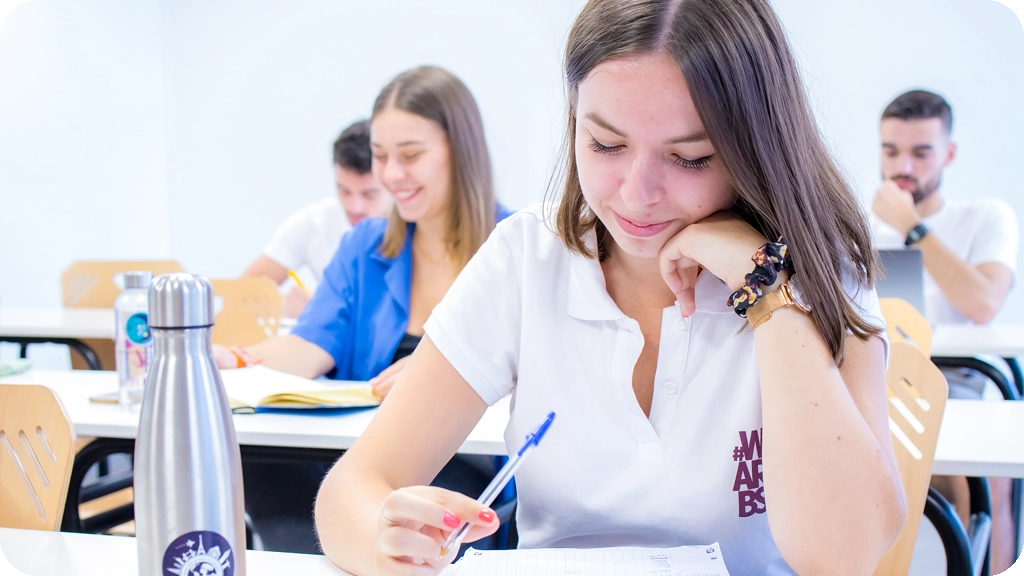Business school student resume: create a resume that stands out

What student resume to join a business school?
It's time to prepare your student resume for business school. Maybe you've already opened Canva or an online generator, picked a template... then stuck with this question: “Is what I have to say really enough? ”
Don't worry, we all felt that. That moment when you wonder if your internships, small jobs or associative commitments are solid enough to impress a jury or a recruiter. Where you fear missing out because you lack experience.
The truth? What makes the difference is not the length of your resume, but its ability to reflect your personality, your potential and your desire to learn.
In this article, we show you how to structure a resume that suits you, use tools (including AI) to your advantage, and avoid mistakes that would make you miss out on a great opportunity. Ready to show who you are? Let's go.
Why is a student resume so important for business school?
You may be saying to yourself: “They already know my grades and have read my cover letter... Does my resume really count? ” The answer is yes.
A resume is much more than just a document listing your experiences. It's your first window. It is he who makes the admission board or the recruiter want to know more.
In a business school, students are expected to be able to sell themselves and to value their assets, even if they do not yet have ten professional experiences to show. A good resume shows your ability to structure your ideas, to prioritize information, and to be clear and impactful.
And then, let's be honest: faced with hundreds of applications, A rough or impersonal resume goes straight into the wrong pile.
At this point, remember that your resume doesn't have to be impressive... but compelling. And that can be worked on.
What should a good student resume for business school contain?
Maybe you don't have years of experience... and that's not what's expected of you. What juries and recruiters want to see is a structured, consistent, and authentic profile. Here's how to build a resume that ticks all the boxes.
Essential sections to include
- Your personal information
First name, last name, address (or city), telephone, professional email and a link to your up-to-date LinkedIn profile. No photo is required, but if you choose one, choose a simple and cheerful portrait. - Your professional objective or project
In a few lines, explain who you are and where you want to go. This short introduction text is often what grabs attention right from the start. - Your training
Indicate your diplomas, your high school or university, dates and possibly your specialties or mentions, especially if they are consistent with the business school project. - Your professional experiences
Internships, small jobs, work-study programs, volunteering... everything counts if you know show what you have learned and contributed. Don't forget to detail your missions and achievements. - Your international experiences
Travelling for pleasure is good... but international business schools, like BSB, expect candidates who can prove their openness to the world. A school exchange, a language trip or a mission abroad show your autonomy and your ability to evolve outside your comfort zone — key qualities for joining a Grande École and taking full advantage of its international exchange programs. - Your key skills
Languages, computer tools, certifications... without an endless list, Name what you really know and that will serve you in your career. - Your personal commitments
Associations, projects, sports, passions... these are differentiating elements that show your curiosity and your ability to get involved.
How to adapt your CV to each school?
A generic resume, sent to all schools or businesses, never works. Each establishment has its values, its priorities, its specificities.
- Read carefully the “values” and “vision” pages schools that interest you.
- Identify the keywords that come up often (leadership, innovation, innovation, impact, international openness, etc.) and include them in your resume if it fits your profile.
- If you are applying for a school that promotes community involvement, highlight your collective experiences. If the focus is international, highlight your language skills and your trips or exchanges.
A suitable resume is a resume that shows the jury that you have understood what they are looking for... and that you are that profile.

What tools and AI should you use to create a compelling resume?
Today, no one starts their CV on Word with a blank page... And that's good. There are powerful — and sometimes unexpected — tools to create an eye-catching, well-structured, professional, and personalized resume. Here's how to take advantage of it.
Resume creation platforms you should know
- Canva : unavoidable. Dozens of free and premium templates that can be customized endlessly. Just be careful not to choose a template that is too used... your resume must remain unique.
- MyCVFactory : models designed for young graduates and students, often more sober and professional than what you will find on mainstream platforms.
- NovoResume, Zety, KickResume : interesting alternatives with writing assistance features and automatic suggestions.
At BSB, we recommend Canva for creativity and MyCVFactory for clarity and structure, and we offer workshops to help our students design their resumes.
Can you use ChatGPT to write your resume?
Yes... but intelligently.
ChatGPT can help you:
- Find effective formulations.
- Restructuring sentences that are too long.
- Adapt your text to the expected tone (more dynamic, more professional).
On the other hand, avoid asking him to write a complete resume for you. You could end up with generic, soulless, and overly formatted content. Use AI as a coach, not as a substitute.
Mistakes to avoid when using automatic models
It's tempting to follow the template that seems ideal for putting your information in. However, templates, while useful, are also likely to be the same for thousands of applications, especially if you use tools like Canva.
- Copy and paste without customizing. Recruiters quickly spot a generic model.
- Forget coherence with your project. Your resume should be about you, not like a school exercise.
- Overdoing it visually. The garish colors, fanciful fonts and graphic overloads interfere with the readability and seriousness of your application.
A good tool never replaces a reflection on your career and a real work of storytelling to tell it.

Do you have to have a LinkedIn profile when you are a student?
How to optimize your LinkedIn profile for business school admission?
You may think that LinkedIn is for “later” when you graduate. Mistake.
Today, business schools and recruiters routinely check your online presence. A clean and well-built LinkedIn profile can make a difference, even as a student.
- A professional photo : sober, smiling, not a selfie.
- A clear title : for example “Motivated student, future manager specialized in digital marketing” or “Business school candidate — passionate about sustainable finance”.
- A summary that tells about your background and your aspirations, without copying and pasting your resume. It's the place to explain who you are and what drives you.
- Informed experiences and skills, even if they are associative or voluntary. Everything counts.
A good LinkedIn profile shows that you are already looking at the professional world and ready to talk to recruiters, alumni, or school students.
Aligning your resume and your online presence: why is it essential?
Imagine a recruiter who reads your resume, type your name on Google... and find an inconsistent or empty LinkedIn profile. You lose credibility instantly.
Your resume and LinkedIn profile should tell the same story:
- Same experiences, same dates.
- Coherence in the discourse.
- Recommendations or interactions (even simple “likes” on publications related to your field) that show that you are active.
At BSB, we make our students aware of this coherence between CV and digital presence very early on, because it has become a key element of a solid application.
Common mistakes on a student resume and how to avoid them
We know it: creating a resume when you have little experience is already stressful. But it would be a shame to waste your efforts with blunders that could cost you a place in the school of your dreams. Here are the mistakes that juries spot in the blink of an eye... and that can close doors for you.
- To say too much or not enough.
A one-page resume, yes, but dense and relevant. Don't try to fill for the sake of filling. And conversely, do not hesitate to detail your missions and what you have learned from them. - A resume that is too generic.
“Dynamic student looking for new opportunities”... that doesn't speak to anyone. Be specific, give personality to your hook and experiences. - Spelling mistakes.
It may seem basic, but a resume with mistakes goes straight into the trash. Have it reread several times. - A confusing layout.
Too many colors, fanciful fonts, or an illegible design interfere with readability. Keep it bright, simple, but modern. - Do not value your soft skills.
Schools are looking for profiles who are able to adapt, communicate and take initiatives. If you have been responsible for an associative project or if you have managed a team in a voluntary setting, say it! - Forget the link to LinkedIn or offer an empty profile.
If you include it, it should be up to date and consistent with your resume. If not, abstain.
A good resume is one that makes you want to meet you. Show who you are, be honest, and focus on what makes you unique.
FAQ — All the questions you have about the student resume for business school
Does a student resume have to be on one page?
Yes. Even if you have a lot to say, learn to synthesize. A clear, readable, one-page resume shows your ability to get to the point.
How to value a lack of professional experience?
Highlight your personal projects, associative commitments, volunteer missions, or your participation in competitions. Anything that shows your sense of initiative counts.
Should we add original projects or areas of interest?
Yes, but only if they add something extra. An entrepreneurial project, event management, a blog, a podcast... Anything that shows curiosity and perseverance is an asset.
How do you stand out when you have little experience?
Take care of your grip. Explain who you are, what you are passionate about, and why you are applying. Show that you are proactive and able to learn quickly.
What layout should be preferred to seduce an admission jury?
Clarity and elegance. Simple colors, an airy structure and a professional design. A classic resume that is perfectly legible is better than a busy template that is difficult to understand.
A student resume for business schools that looks like you... and that opens doors
A student resume is not a simple imposed exercise. It is your business card, your first impression. You are not asked to be perfect, but to be sincere, structured, and committed.
You have more to say than you think. Each experience, each project tells something about you. And it's these details that can tip the scales.





To remember